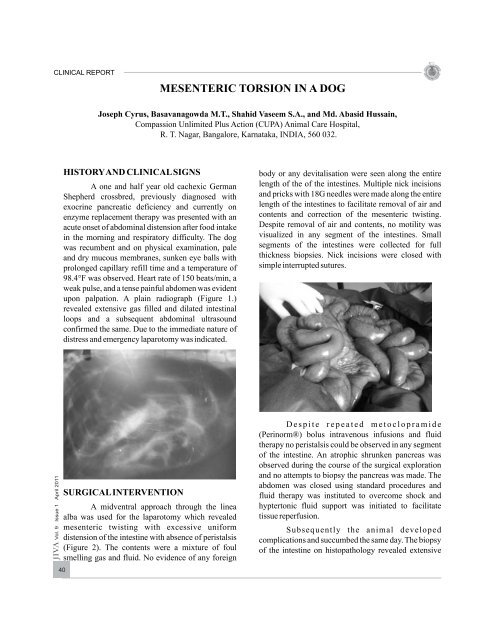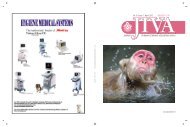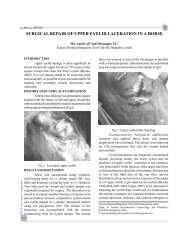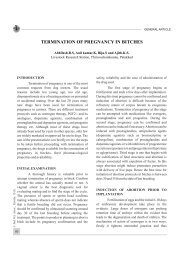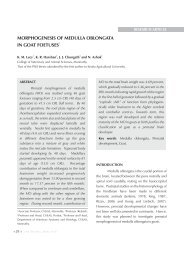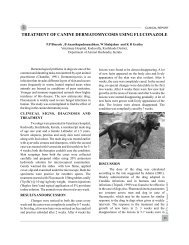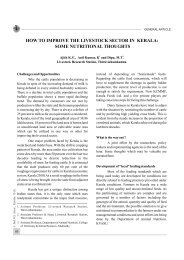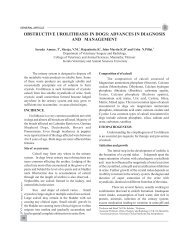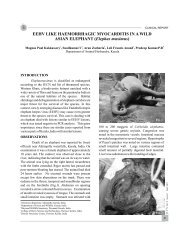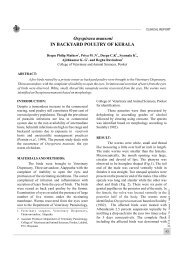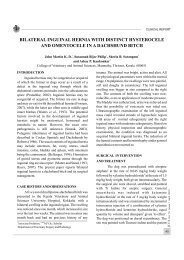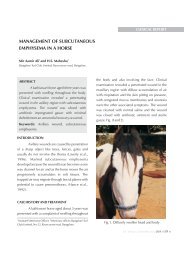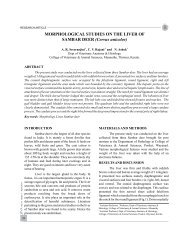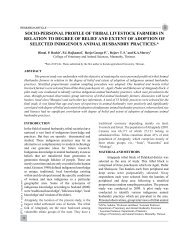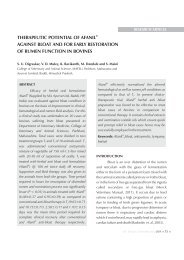Mesenteric torsion in dogs - Jivaonline.net
Mesenteric torsion in dogs - Jivaonline.net
Mesenteric torsion in dogs - Jivaonline.net
Create successful ePaper yourself
Turn your PDF publications into a flip-book with our unique Google optimized e-Paper software.
CLINICAL REPORTMESENTERIC TORSION IN A DOGJoseph Cyrus, Basavanagowda M.T., Shahid Vaseem S.A., and Md. Abasid Hussa<strong>in</strong>,Compassion Unlimited Plus Action (CUPA) Animal Care Hospital,R. T. Nagar, Bangalore, Karnataka, INDIA, 560 032.HISTORYAND CLINICAL SIGNSA one and half year old cachexic GermanShepherd crossbred, previously diagnosed withexocr<strong>in</strong>e pancreatic deficiency and currently onenzyme replacement therapy was presented with anacute onset of abdom<strong>in</strong>al distension after food <strong>in</strong>take<strong>in</strong> the morn<strong>in</strong>g and respiratory difficulty. The dogwas recumbent and on physical exam<strong>in</strong>ation, paleand dry mucous membranes, sunken eye balls withprolonged capillary refill time and a temperature of98.4°F was observed. Heart rate of 150 beats/m<strong>in</strong>, aweak pulse, and a tense pa<strong>in</strong>ful abdomen was evidentupon palpation. A pla<strong>in</strong> radiograph (Figure 1.)revealed extensive gas filled and dilated <strong>in</strong>test<strong>in</strong>alloops and a subsequent abdom<strong>in</strong>al ultrasoundconfirmed the same. Due to the immediate nature ofdistress and emergency laparotomy was <strong>in</strong>dicated.body or any devitalisation were seen along the entirelength of the of the <strong>in</strong>test<strong>in</strong>es. Multiple nick <strong>in</strong>cisionsand pricks with 18G needles were made along the entirelength of the <strong>in</strong>test<strong>in</strong>es to facilitate removal of air andcontents and correction of the mesenteric twist<strong>in</strong>g.Despite removal of air and contents, no motility wasvisualized <strong>in</strong> any segment of the <strong>in</strong>test<strong>in</strong>es. Smallsegments of the <strong>in</strong>test<strong>in</strong>es were collected for fullthickness biopsies. Nick <strong>in</strong>cisions were closed withsimple <strong>in</strong>terrupted sutures.JIVA Vol. 9 Issue 1 April 2011SURGICAL INTERVENTIONA midventral approach through the l<strong>in</strong>eaalba was used for the laparotomy which revealedmesenteric twist<strong>in</strong>g with excessive uniformdistension of the <strong>in</strong>test<strong>in</strong>e with absence of peristalsis(Figure 2). The contents were a mixture of foulsmell<strong>in</strong>g gas and fluid. No evidence of any foreign40Despite repeated metoclopramide(Per<strong>in</strong>orm®) bolus <strong>in</strong>travenous <strong>in</strong>fusions and fluidtherapy no peristalsis could be observed <strong>in</strong> any segmentof the <strong>in</strong>test<strong>in</strong>e. An atrophic shrunken pancreas wasobserved dur<strong>in</strong>g the course of the surgical explorationand no attempts to biopsy the pancreas was made. Theabdomen was closed us<strong>in</strong>g standard procedures andfluid therapy was <strong>in</strong>stituted to overcome shock andhyptertonic fluid support was <strong>in</strong>itiated to facilitatetissue reperfusion.Subsequently the animal developedcomplications and succumbed the same day. The biopsyof the <strong>in</strong>test<strong>in</strong>e on histopathology revealed extensive
CLINICAL REPORTulcerations devoid of any <strong>in</strong>flammatory or neoplasticcells.DISCUSSIONIntest<strong>in</strong>al hypomotility are not well characterized <strong>in</strong><strong>dogs</strong> to be associated with primary causes. Secondarycauses <strong>in</strong>clude prior surgery, pertitonitis, pancreatitis orparvoviral <strong>in</strong>fections. However as <strong>in</strong> malabsorptivedisorders, undigested and osmotically active particles<strong>in</strong> the <strong>in</strong>test<strong>in</strong>al lumen are know to decrease transit timehowever are responsive to prok<strong>in</strong>etics likemetoclopramide (Allenspach and Gaschen, 2008).However the latter did not hold true <strong>in</strong> this case. Themalabsorption may be attributed to exocr<strong>in</strong>e pancreatic<strong>in</strong>sufficiency however the reason for hypomotilityrema<strong>in</strong>s unknown. However, a <strong>in</strong>creased prevalence ofmesenteric <strong>torsion</strong> have been reported <strong>in</strong> GermanShepherd <strong>dogs</strong> <strong>in</strong> F<strong>in</strong>land with pancreatic ac<strong>in</strong>ar atropy,a major cause of exocr<strong>in</strong>e pancreatic <strong>in</strong>sufficiency(Williams, 2005) but has not been reported anywhereelse.Mortality associated with mesenteric <strong>torsion</strong> isalmost 100%, especially <strong>in</strong> GermanShepherds(Westermarck and Rimaila-Parnanen, 1989).Prompt surgical <strong>in</strong>tervention has been associated withpoor survival <strong>in</strong> this breed as was <strong>in</strong> this cl<strong>in</strong>ical case.Most deaths reported are dur<strong>in</strong>g recovery fromanaesthesia and is usually the result from a comb<strong>in</strong>ationof hypovolemia, bacterial translocation due to mucosalbarrier breakdown and subsequent toxemia.Reperfusion <strong>in</strong>jury with the correction of mesenteric<strong>torsion</strong> is also believed to be associated with therelease of reactive oxygen species which havedeleterious effects on tissues and is believed to set <strong>in</strong>with<strong>in</strong> the first few m<strong>in</strong>utes of surgical correction(Junius,Appeldoorn, and Schrauwen, 2004).Diagnosis of mesenteric <strong>torsion</strong> is difficultas cl<strong>in</strong>ical signs are nonspecific and the condition isrelatively rare, however association with exocr<strong>in</strong>epancreatic <strong>in</strong>sufficiency or German Shepherd <strong>dogs</strong>should warrant radiographic exam<strong>in</strong>ation andemergency explorative laparotomy to <strong>in</strong>crease theodds of survival.REFERENCESAllenspach, K. And Gaschen, F. P., Small Intest<strong>in</strong>alDiseases. In: Small Animal Gastroenterology,Ste<strong>in</strong>er, J.M., (ed.),Schlutersche, 2008Junius, G., Appeldoorn, A. M. and Schrauwen, E.,2004. <strong>Mesenteric</strong> volvulus <strong>in</strong> the dog:aretrospective study of 12 . J. Small Anim.Pract., 45:104-107Westermarck, E. and Rimaila-Parnanen, E.,1989<strong>Mesenteric</strong> <strong>torsion</strong> <strong>in</strong> <strong>dogs</strong> with exocr<strong>in</strong>epancreatic <strong>in</strong>sufficiency: 21 cases (1978-1987).JAm Vet Med Assoc ;195(10):1404-1406.Williams, D.A.2005, Disease of the exocr<strong>in</strong>epancreas. In: BSAVA Manual of Can<strong>in</strong>e andndFel<strong>in</strong>e Gastroenterology, 2 Ed., Edt. Hall, E.J.,Simpson, J. W.AndWilliams, D. A., BSAVA, .INFOMANIA Anwers1. Gastronomy2. Umami3. Scoville scale4. Complete loss of taste5. Mono sodium Glutamate(Aj<strong>in</strong>omoto)6. The Omnivore's Dilemma7. A diet which <strong>in</strong>cludes fish but no meat.8. Cuis<strong>in</strong>e9. Shawarma10. Sundae11. Porotta12. Pouss<strong>in</strong>13. Taste14. Oenology15. NutrigenomicsJIVA Vol. 9 Issue 1 April 201141


